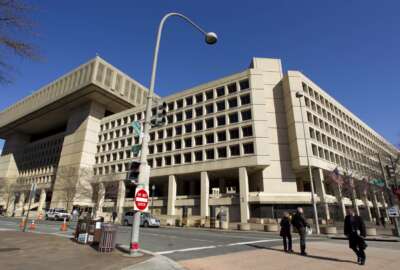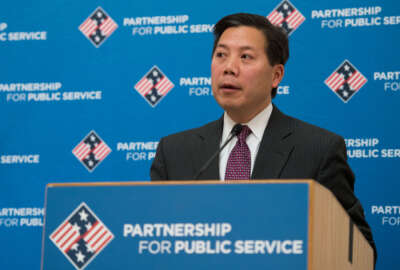
FBI headquarters cancellation fits pattern, symptomatic of deeper issues
Chris Lu, former deputy secretary for Labor, says the department also had its search for new headquarters canceled. And Dan Tangherlini, former General Services...
The cancellation of the search for a new FBI building wasn’t the first time the Trump administration has done this. Instead, it’s the most recent example in a growing pattern, according to Chris Lu, former deputy secretary of Labor.
Lu said that in January 2017, the Labor Department was well on its way to finding a replacement for its headquarters, the Frances Perkins building. He said the old headquarters has tens of millions of dollars worth of issues, including rodents, wasted space, lack of wifi and heating/cooling problems.
Labor was using the same building exchange program as the FBI to help defray the costs of the new headquarters. Lu said the location of the old building, on Constitution Avenue adjacent to Interstate 395, is quite valuable, and Labor has no problems with moving to a less desirable part of town to unlock that value.
That’s the heart of the exchange program — the contractor that provides the new building gets the old location as part of the payment, and the government saves a significant amount of money.
“This exchange process that was begun or envisioned by the former GSA Administrator Dan Tangherlini was I think a creative way to try to address the budgetary constraints that all federal agencies are under,” Lu told the Federal Drive with Tom Temin.
Tangherlini said that the process worked extremely well with the Volpe Transportation Center. So well, in fact, that the government stands to make hundreds of millions of dollars on the deal.
Most of the other options to replace an aged and ailing building simply aren’t practical. Lu said the departments of Commerce and the Interior tried rehabilitating their buildings, but in order to do so, they had to temporarily move their workforces out and then back in, doubling their moving costs while construction costs also rose during the projects.
Not to mention the fact that rehab isn’t always financially viable in the first place. According to a 2011 Government Accountability Office report, it would cost more than $3 billion to rehabilitate the J. Edgar Hoover FBI building, and that’s before addressing the problems of security and efficiency.
Tangherlini said that leasing isn’t really an option either; it’s difficult to find available spaces that size, and it isn’t cost effective.
But he said he was surprised that the administration wasn’t able to find any options to reduce cost while continuing the search.
“I have a lot of faith in the technical ability of the highly qualified professional staff at GSA, but I find that a little hard to believe, to be perfectly honest,” Tangherlini told the Federal Drive with Tom Temin. “I think that there were options — they could have descoped the project, they could have phased the project. … I think that there were many options. So I think, to some extent, I hope that the people participating in the process have gotten a better explanation, and more importantly, I think that the american taxpayers deserve to know what the plan B is. Simply saying that we’re not going to do anything about the FBI headquarters is not a sustainable path.”
Regardless, he said the government needs to come up with another plan to move forward before there’s an adverse effect on morale due to employee uncertainty about the future.
“The most important thing, really, is what are we going to do about the most important federal law enforcement agency, the fact that it is in a non-functional and frankly unsafe building?” he said. “That’s why saying, ‘We’re not going to do this’ is an easy answer. Saying what you’re going to do instead is the critical question.”
Although he’s no longer with the Labor Department, Lu has heard that employees are already starting to wonder what’s going to happen in the future.
Tangherlini said this is symptomatic of a deeper problem with federal real estate. The current methods are the least effective and most costly.
“We haven’t had a meaningful, thoughtful, smart discussion about the way we handle capital investments in the federal government in many, many years. It’s time to do that. And if there really is an infrastructure bill and an infrastructure effort that’s being contemplated, this should be part of the discussion as well,” he said. “The big issue is that we have a one-year budget, we don’t have a capital budget. And the rules that we operate under for that one-year budget actually favor operating expenses and tax transfers, entitlements, over capital expenditures. I think it’s a deeply concerning issue about the way we budget the federal finances.”
Copyright © 2025 Federal News Network. All rights reserved. This website is not intended for users located within the European Economic Area.
Daisy Thornton is Federal News Network’s digital managing editor. In addition to her editing responsibilities, she covers federal management, workforce and technology issues. She is also the commentary editor; email her your letters to the editor and pitches for contributed bylines.
Follow @dthorntonWFED
Related Stories






